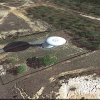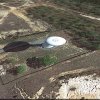I have a lot of very tall pine trees in Georgia plus some interesting structures like antenna towers, water tanks, etc. I was wondering what the best and safest method would be to use my Mavic Pro to measure the AGL of these things. Can the camera horizon line or the cross hatch display be used for alignment of the top even if your flying a safe distance away like from 30-60 feet? It would seem logical since the drone is level and the altitude reading in the DJI app is pretty accurate +/- a foot I would think. What advice do you experienced pilots have to share?
You are using an out of date browser. It may not display this or other websites correctly.
You should upgrade or use an alternative browser.
You should upgrade or use an alternative browser.
Using a Mavic Pro to measure height of structures and trees?
- Thread starter MavicMikeK
- Start date
- Joined
- May 25, 2017
- Messages
- 8,491
- Reactions
- 7,976
- Age
- 61
Maybe with camera gimbal straight ahead, and using the photo gridlines displayed, the centre square might be pretty much horizontal to whatever's in the viewer.
You'd have to test this on things closer to the ground to confirm.
Then as per post by @Fleek you should take off very close to the structure or tree base and up to get the altitude, I'd say you could be accurate to within a metre or so with some practice.
If you can't get to the base for take off, you will first have to do something similar from take off point to the base of whatever, then see alt, then up you go to the top, then it's a simple subtraction.
You'd have to test this on things closer to the ground to confirm.
Then as per post by @Fleek you should take off very close to the structure or tree base and up to get the altitude, I'd say you could be accurate to within a metre or so with some practice.
If you can't get to the base for take off, you will first have to do something similar from take off point to the base of whatever, then see alt, then up you go to the top, then it's a simple subtraction.
In my opinion, drones are not suitable for precise measuring. Because of the cheap gps units and small antennas. In best conditions the horizontal absolute precision is not better than three meters and the vertical one is 2-3 times worse. A good phone can do the same. Precision gps units costs a lot of money and cannot be carried by usual drones.
- Joined
- May 27, 2017
- Messages
- 14,458
- Reactions
- 19,469
- Location
- Los Alamos, NM
- Site
- www.mavicpilots.com
In my opinion, drones are not suitable for precise measuring. Because of the cheap gps units and small antennas. In best conditions the horizontal absolute precision is not better than three meters and the vertical one is 2-3 times worse. A good phone can do the same. Precision gps units costs a lot of money and cannot be carried by usual drones.
They don't use GPS as the primary measurement of altitude - it's barometric. It's fairly accurate in standard atmospheric conditions - plus or minus a few percent. GPS vertical accuracy is probably a little better than your numbers, especially with WAAS and especially if you are looking at altitude difference, partly because when airborne they generally have a very large number of satellites to work with. The GPS vertical data are recorded in the DAT log files.
Sprocket
Well-Known Member
I have a lot of very tall pine trees in Georgia plus some interesting structures like antenna towers, water tanks, etc. I was wondering what the best and safest method would be to use my Mavic Pro to measure the AGL of these things. Can the camera horizon line or the cross hatch display be used for alignment of the top even if your flying a safe distance away like from 30-60 feet? It would seem logical since the drone is level and the altitude reading in the DJI app is pretty accurate +/- a foot I would think. What advice do you experienced pilots have to share?
You could go here: SkyVector: Flight Planning / Aeronautical Charts and get accurate heights of the towers you mentioned. Then compare that number to what the drone reports.
edit: Or you might try this: FCCInfo - Now on Google Earth!
- Joined
- May 27, 2017
- Messages
- 14,458
- Reactions
- 19,469
- Location
- Los Alamos, NM
- Site
- www.mavicpilots.com
You could go here: SkyVector: Flight Planning / Aeronautical Charts and get accurate heights of the towers you mentioned. Then compare that number to what the drone reports.
edit: Or you might try this: FCCInfo - Now on Google Earth!
A fairly accurate way to measure height is simply to take an elevation angle from a known location. There are plenty of digital tools that will do that, and also smartphone apps (e.g. Theodolite) that will do that fairly accurately once the accelerometers on the mobile device have been calibrated.
Great advice from everyone, thanks! I guess there is some percentage of error in the altitude from the barometric sensors and the gps satellites because when I flew my MPP up to the 400 ft limit my DJI app stopped me and said I couldn't go any higher even though my altitude read 392 feet. This is about a 5% error which surprised me a little since I thought it would be more accurate being that the ground sensors know precisely when landing. Maybe they're not linked to the AGL numbers or barometrics?
If you all saw the google earth water tower 3D screenshot I posted maybe you can answer another question about it that I have? If I fly to this tower and want to set my POI from directly above it would I be able to see any antennas that might be there with the MPP camera? I was planning to go above it like 50 feet for the POI centering which should be well above any type of antenna however turning the gimbal downward would be nearly impossible to see a tiny antenna stick from looking above it. Then I'll need to fly outwards to a certain radius at least 50 feet greater than that of the tank which should be fairly easy using the camera views angle as I'm flying downwards along the sides of the tank. I then want to video a do a 360 around the tank using the autonomous mode.
Your experienced thoughts and suggestions?
If you all saw the google earth water tower 3D screenshot I posted maybe you can answer another question about it that I have? If I fly to this tower and want to set my POI from directly above it would I be able to see any antennas that might be there with the MPP camera? I was planning to go above it like 50 feet for the POI centering which should be well above any type of antenna however turning the gimbal downward would be nearly impossible to see a tiny antenna stick from looking above it. Then I'll need to fly outwards to a certain radius at least 50 feet greater than that of the tank which should be fairly easy using the camera views angle as I'm flying downwards along the sides of the tank. I then want to video a do a 360 around the tank using the autonomous mode.
Your experienced thoughts and suggestions?
Attachments
I thought they went extinct millions of years ago...lol
Anyways, I prefer the fun aspect of using my drone vs doing trig.
Anyways, I prefer the fun aspect of using my drone vs doing trig.
bushie
Well-Known Member
I would fly reasonably close to the object and climb till the horizon and the top of the object line u and then read the drones height. Only works in relativly flat country with the horizon a good distance away.
I would fly reasonably close to the object and climb till the horizon and the top of the object line u and then read the drones height. Only works in relativly flat country with the horizon a good distance away.
Good points, I forgot about the difference in ground level from the take off point to the measurement area. Even if they are 200-500 feet away there could be 5-10 feet or more on uneven ground. Thanks for the advice!
Similar threads
- Replies
- 6
- Views
- 677
- Replies
- 20
- Views
- 7K
- Replies
- 40
- Views
- 4K
- Replies
- 2
- Views
- 2K
DJI Drone Deals
1. Mini 2
2. Mini 3 Pro
3. Mini 4 Pro
4. Air 2s
5. Air 3
6. Avata 2
7. Mavic 3 Pro
8. Mavic 3 Classic
2. Mini 3 Pro
3. Mini 4 Pro
4. Air 2s
5. Air 3
6. Avata 2
7. Mavic 3 Pro
8. Mavic 3 Classic
New Threads
-
Mini 4 Not Mine but amazing drone video beautiful crazy penguins
- Started by Daytona500
- Replies: 0
-
Why is there not a Mini 3 pro section? Seems like it's ignored.
- Started by Shuttersky597
- Replies: 4
-
Air 2s Salt Lakes of the Mallee, Victoria, Australia
- Started by RobinM
- Replies: 2
-
Mini 4 Moose On The Loose In Eastern Canada
- Started by Jug's Life
- Replies: 0
-
Members online
Total: 839 (members: 6, guests: 833)














